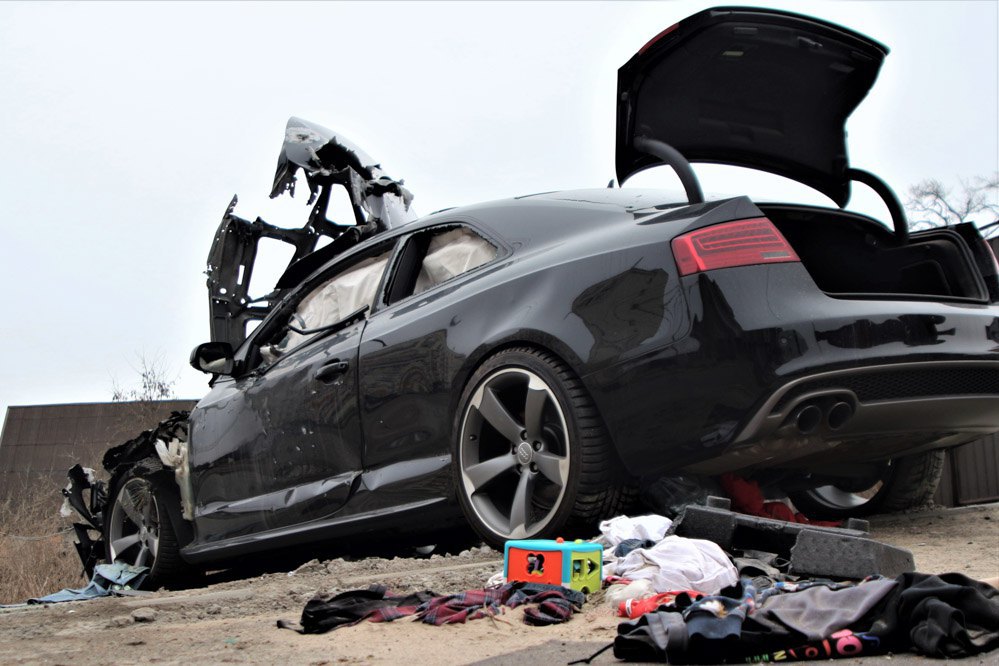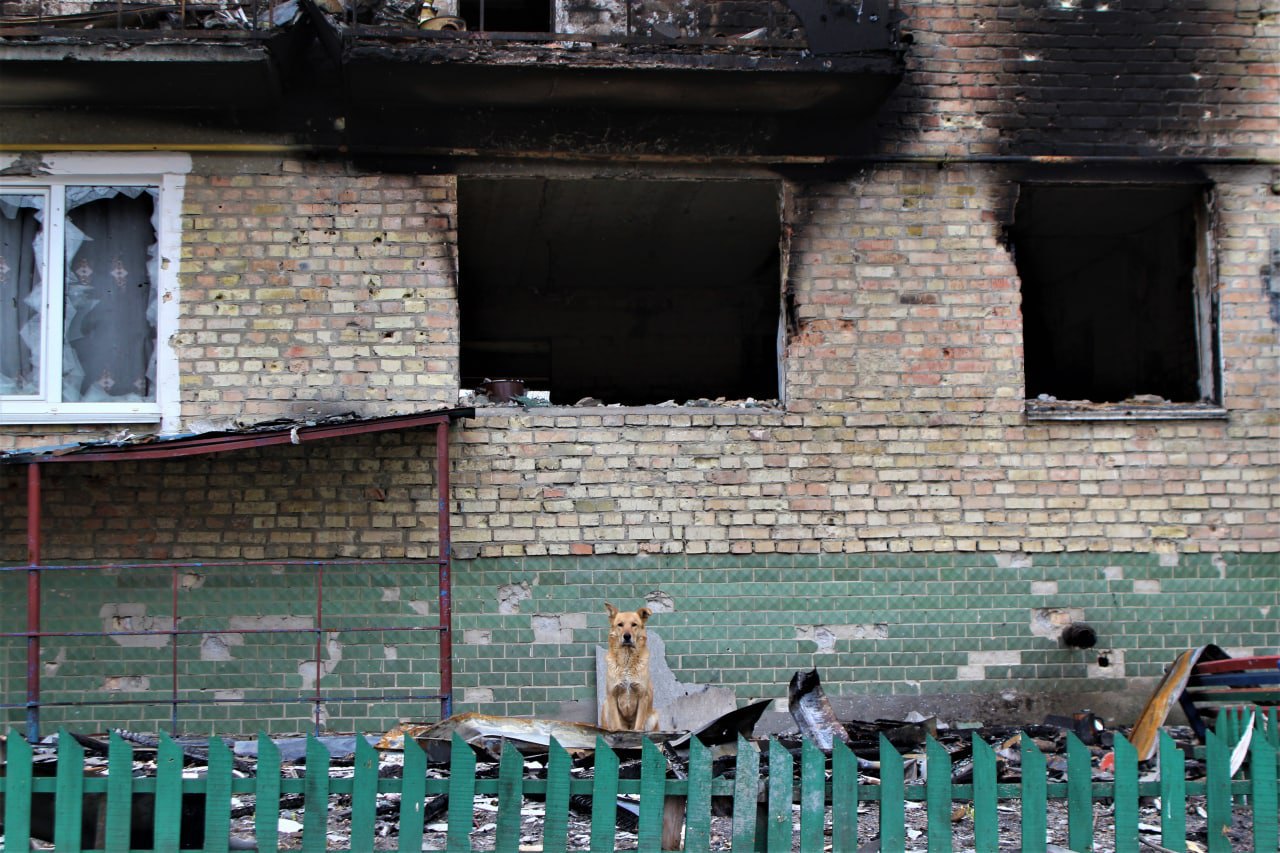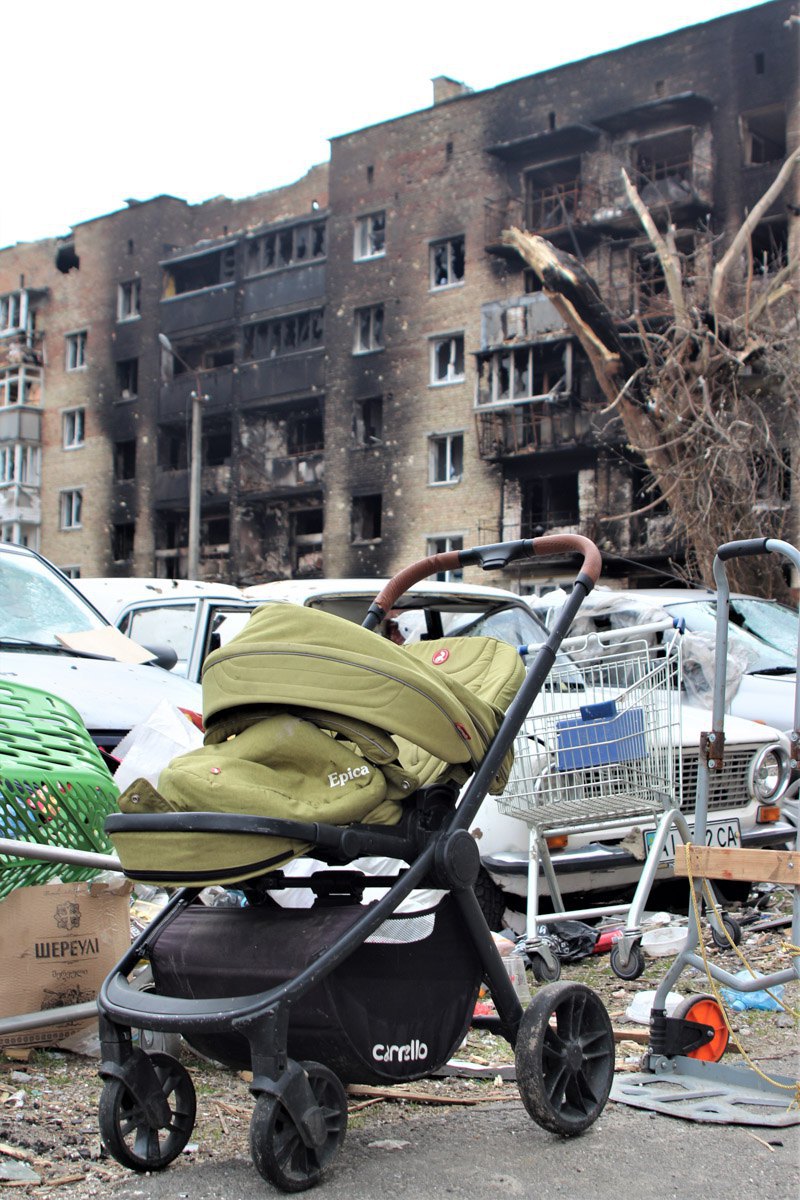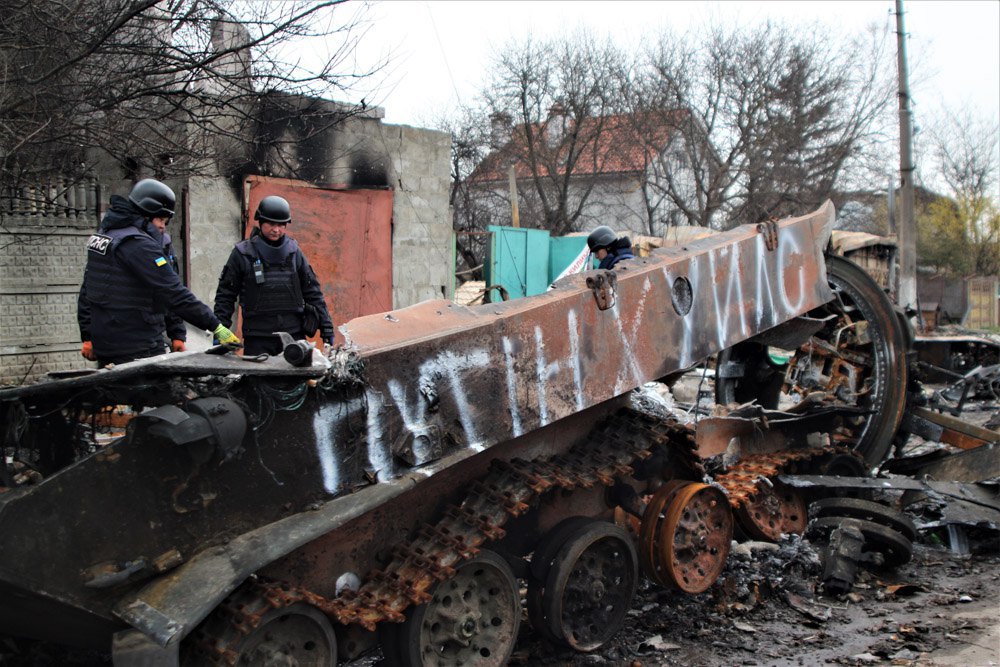Stoianka. "Here was a shot car with children, at the corner - another"
We leave Kyiv at 8:30 am along with a column with the officers of the Security Service of Ukraine. "Surprises" from the russian occupiers began almost immediately after we left the capital. They dug in and generously mined the forests next to Kyiv. At the entrance to the village of Stoianka, we first see damaged trees, destroyed apartments in beautiful new buildings, shell casings from the "gun" and broken equipment of russians with the mark "V."
"Here was a shot down car with children, at the corner - another. The bodies of the killed people have already been taken," - says the Commander of the assault team of the separate troop of TDF of Irpin.
We pay attention to the car with the inscription "Children." The windscreen is bullet-ridden with two shots from the assault rifle. Nearby, another car is crushed by fragments of missiles. In the front seat there is a children's boot and a women's perfume, in the trunk there are toys.


The soldier made the clearance operation of the territories of the Kyiv region while the trail was still hot. He recalls that a few days ago he counted about 40 killed children in the Hostomel direction.
"I was shocked by the mass of people who were shot in the cars when they wanted to escape. The russians were not trying to figure out who was in the car. They simply shot everyone without remorse. People were killed with 30-caliber armored assault vehicles. There were also single bursts from the 5.45 and 7.62 caliber assault rifles. Then the russians cynically robbed cars," - says the volunteer Oleksandr.
After a few hundred meters we see again the eliminated enemy equipment. Nearby is what is left of those who came thereon.
"The russians, in order to retrieve the body of their killed war buddy, cut off his legs up to his knees, because they boiled to the asphalt so that they could not tear off. You see, it's a tank soldier. This often happens to them, to russian tank soldiers," - says Oleksandr.

Irpin. "The russian occupiers killed civilians purposefully, tortured them in cold blood, committed sexual, physical, and mental violence, and used them as slaves"
We enter the city of Irpin, where since 2015, Sevas lived with his family after leaving the Crimea. Before the war, it was traditionally included a list of the best Ukrainian cities for life. Now the ground here is covered with debris and not detonated missiles. Near the Cultural Center we see a shot, but not removed the Ukrainian flag, as well as the flags of the European Union and some European countries.

We go to a position called "Giraffe". It was here where the Territorial Defense Forces of Irpin exclusively on its own actively restrained the enemy for 24 days. In the early days, local men evacuated their families and fought for their homes. They successfully restrained the enemy, because many of them have combat experience. The russians generally believed that this position secured Ukrainian Special Forces.
"About 30% of our troops are combatants. In the early days, the most active of them united. The troop initially numbered about 30 people, and then the number increased to 200 fighters. From the intercepted conversations of the occupiers, it is obvious that they thought that we were Ukrainian Special Forces, who changed our clothes deliberately to disorientate them," - tells the volunteer.
Near the checkpoint of the Ukrainian military, we are "met" by two burned cadavers of the russian soldiers. Oleksandr says they are intelligence officers. Their three-car column was eliminated in the first week of the war.
"Even dogs are disgusted by them," - he adds.

We found out from him that the sniper position of our fighters here was "blew off" completely, and the Ukrainian tank remained unbroken despite constant shelling. A residential house near it was burnt out. A big red dog does not walk off from it. Sevas assures us that most of the animals were taken and rescued. There are, obviously, the most loyal…










After Oleksandr, we pass carefully, watching closely our steps, because the clearance operation is still ongoing. The land is densely dotted with branches of trees, which were dumped by the enemy shells.
"The areas where we defended were most affected. Once in this location, there were 300 "approaches" from different types of weapons: mine throwers, and howitzers. This is the building where we kept the defense. Nearby is a bomb shelter, where about 160 civilians were hiding: women, children, men. Our resistance was serious, and the support of residents was strong. They offered to help us. Russians hated civilians for providing us with information on the movement of columns of russian equipment and adjustment of our artillery. The russian occupiers killed civilians purposefully, tortured them in cold blood, committed sexual, physical, and mental violence, and used them as slaves. The russians have always behaved like a horde," - says the warrior.

According to Oleksandr, in the most difficult moments under constant shelling, almost 26 thousand civilians were evacuated by fighters of the local Territorial Defense Forces during the week.
Bucha. "Russian foot troops sat on the armored assault vehicle. They scattered like pins in different directions. Among them was the Commander of the unit. It's pieces left of him"
Soon we see at the exit road from Irpin to Bucha, on the side of the road the body of the retiree in civilian clothes. On his hand, he has a white bandage. Around him, there is a box of wine glasses, a coffee maker, candies, and a vacuum cleaner in the bag.
"This is a civilian captive. We are now at the forefront of the enemy. The russians could not cross the road, because we could shoot them. Therefore, they forced civilians to dig trenches, cook food, and maraud," - explains our guide.

In Bucha today cleaned up a column of defeated enemy equipment, which consists of more than 10 units: several Armored Assault Vehicle-2, Armored Assault Vehicle-3, Armored Personnel Carriers-80, Armored Personnel Carriers-82А, command staff vehicle. Among the mass of scrap metal are the remains of 120 tank shells and various ammunition of rifled and smooth-bore weapons, as well as scattered ear-flapped hats and chemical protection suits. At the beginning of the column is a boot with a human bone.
"One day a paratrooper from the 80th brigade joined us, he fired in straight under the "tower" from the RPG-7, and the ATGM detonated. The russian foot troops sat on the armored assault vehicle. They scattered like pins in different directions. Among them was the Commander of the unit. It's pieces left of him: armored plate and burned "striped vest," - says the fighter.








Vorzel ring. "We were surrounded by the russian occupiers for four hours. It was very tough. More than 20 of our people died here"
Soon, we find ourselves near the exit to Vorzel, the so-called "Vorzel ring", and Oleksandr comes out of the car to look for the grave of the killed war buddy before his eyes.
"On March 5, just on my birthday, we went to pull the Azov people out of the surrounding. This russian "KAMAZ" we burned, and then the problems began... We started to be clamped down on all sides. We were surrounded by the russian occupiers for four hours. It was very tough. More than 20 of our people died here. One person in my group died before my eyes, simply two meters away. He was hit by the burst from the machine gun. He didn't get to the shelter, he just fell in front of me. I tried to reach out to him, but I couldn't. About a minute I saw him die," - Oleksandr shares his memories.
Return road. "You have no idea what a beauty it is to listen to silence. Minute, minute and a half, two, and no bombs. We're out of it. "
For a long time on the return road, we just keep quiet.
A resident, Ibrahim Tatiev, meets us at a bomb shelter in Irpin. Before the war, the man worked as a lawyer.
He recalls that because of heavy shellings, every night he said goodbye to life:
"The russians entered our city in early March. Out the window, I saw their tanks and hid in a room on the third floor. And then I saw three russian soldiers in our yard. They were stealing something from small shops. I hid in the apartment again, because I thought that if they saw me, they would shoot or take me as a captive. So many people were taken like captives... I did not show myself for a few days, and then I saw that their tanks stopped expeditionary trips to the bridge on Romanivka. And once I noticed that the Commander of their tank came out of the hatch and looked in my direction. I hid again because I was unarmed. Then my phone was discharged. Within a few days, colleague-lawyer fighting in the Territorial Defense Forces asked his friends to visit me. I was invited to a bomb shelter. It turned out there was someone else there. On good days, up to 50 people hid with me. Our kitchen was commanded by Doctor of Historical Sciences, Iryna Hennadiivna, every day we cooked porridge there, and made some tea. The main need was drinking water. Volunteers somehow made their way to us, although the russians were still there. We wouldn’t go out of the shelter because of serious shellings, and they have brought everything we need, walking on death! Shellings here were scary. Especially at night. Every night was a farewell to life. We had a corner with Orthodox icons. They shelled, and people prayed and said goodbye to life. Every night it all happened before my eyes. I am a Moslem myself, but I prayed with them because God is single... In the war, the most terrible are sounds. You can't imagine the beauty of listening to silence. Minute, minute and a half, two, and no bombs. We're out of it. "

From Ibrahim we learned that some locals have already returned to their homes, although there is no water or light yet. Mine clearance specialists carried out clearance operations of central streets, then must be a thorough inspection of roads and premises. Therefore, civilians are advised to wait for the entire territory to be cleared.
Finally, Sevas concludes: "You know, if we had completely given up them Irpin, the occupiers could have openly "worked" through the center of the capital. In fact, I believe that the suburbs played an important role in the fact that Kyiv survived."









